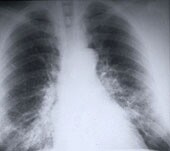
TUESDAY, April 17 (HealthDay News) — Medicare patients who have advanced non-small cell lung cancer appear to get no survival benefit from adding the drug Avastin to standard chemotherapy, researchers from the Dana-Farber Cancer Institute report.
An earlier trial had found that Avastin (bevacizumab) did improve survival, but not in patients aged 65 and older. Even so, the researchers noted, most patients diagnosed with non-small cell lung cancer are 65 and older and Medicare still covers the cost of the drug.
“A drug that we were just ecstatic about in 2006, we have to be more circumspect about,” said lead researcher Dr. Deborah Schrag, an oncologist at Dana Farber, in Boston.
Avastin should be used judiciously, she added, noting that “older patients should discuss it with their doctors, but we cannot say it provides a survival advantage based on these data.”
However, Schrag does not think Medicare needs to reconsider funding Avastin. “It may be that it helps some patients,” she said. “But we should not assume that Avastin needs to be part of the treatment package.”
Genentech, the maker of Avastin, said in a statement Tuesday that while the study “is well-conducted, retrospective analyses that use administrative information to determine clinical outcomes have limitations.”
“Genentech agrees that certain people, such as those older than 65, are typically underrepresented in randomized, controlled clinical trials used for regulatory submissions. To address this, we collect and present data on the ‘real world’ use of medicines through large phase 4 prospective observational studies, which even when well-designed, also have limitations, including non-randomization of study participants.”
The cost of the medication is also a factor in considering the use of Avastin, experts have said.
In 2011, published reports pegged the cost of the drug at somewhere between $4,000 and $9,000 a month, depending on co-pay assistance that’s available from Genentech, Avastin’s manufacturer.
This latest report was published in the April 18 issue of the Journal of the American Medical Association. The U.S. National Cancer Institute funded the study.
For the study, Schrag’s team randomly assigned more than 4,000 Medicare patients with advanced non-small cell lung cancer to one of two groups.
One group received Avastin plus chemotherapy, while the other group was treated with chemotherapy alone. The researchers compared survival between the groups.
They found average survival for patients receiving Avastin plus chemotherapy was 9.7 months, compared with as much as 8.9 months for patients on chemotherapy alone.
In terms of one-year survival, it was 39.6 percent for those getting Avastin and chemotherapy and 40.1 percent for chemotherapy alone.
When they took into account demographic and clinical characteristics in adjusted models, the researchers did not find a significant difference in overall survival between patients treated with Avastin and chemotherapy and those treated only with chemotherapy.
Dr. Norman Edelman, chief medical officer of the American Lung Association, said, “As I pointed out in the past, it is important to study ways to extend quality of life in advanced lung cancer.”
This study shows that a drug that was useful in a general age group is not effective in an older age group, he added. “Thus, it may save older patients exposure to an ineffective drug with side effects,” he said.
“It is critical that, to the extent possible, we study treatments separately in groups known to differ in responses, rather than subject all to average responses,” he said.
More information
For more information on lung cancer, visit the U.S. National Cancer Institute.

